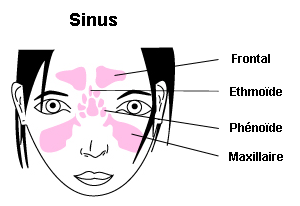Sinusitis
Sinusitis is an inflammation of the tissue in the sinuses. The sinuses are cavities in the bones of the face. There are four pairs of sinuses, located around the nose and eyes, connected to the nasal cavities by small openings. They produce mucus that helps keep the nose clean.

The main symptoms of sinusitis are:
- Nasal congestion
- Greenish or yellowish nasal secretions
- Pain or pressure in the face
- Diminished or lost sense of smell
- Headaches
- Tooth pain
- Fever
- Cough
Causes and triggers
Most of the time, sinusitis is caused by a virus such as a cold or flu virus. Viruses cause inflammation inside the nose, blocking the openings between the sinuses and the nasal cavities. As a result, mucus can no longer escape and clogs up the sinuses.
There are two types of sinusitis: acute and chronic. Acute sinusitis usually lasts from 1 to 3 weeks. Chronic sinusitis occurs when symptoms persist for at least 3 months.
Treatment
Acute sinusitis usually goes away on its own within 1 to 3 weeks. Treatment for sinusitis focuses on relieving symptoms. Analgesics (e.g., Tylenol, Advil, or Motrin) may be used to relieve pain. You can also rinse your nasal passages a few times a day with a saline solution (e.g.,Sinus Rinse or Hydrasense). Unless you've been advised not to, drink plenty of fluids. This will help your mucus drain more easily. Lastly, adults can use a decongestant nasal spray. Don't hesitate to ask your pharmacist for advice.
If your symptoms don't improve after a few days, you may need to take an antibiotic. It's important to follow your health care provider's instructions and finish the full course of your prescription.
A few simple steps can help reduce the risk of developing sinusitis, such as:
- Getting vaccinated against pathogens that cause respiratory infections
- Washing your hands frequently
- Maintaining good nasal hygiene with saline solution
- Quitting smoking and maintaining a healthy, smoke-free environment
When should I see a health care professional?
Consult your health care provider if your symptoms last more than 10 days or if they worsen. Seek care immediately if you experience any of the following symptoms:
- High fever
- Neck pain or stiffness
- Sudden or severe headache or facial pain
- General feeling of being ill
- Brain fog
- Redness or discharge around the eyes
- Vision problems or double vision
© Copyright Vigilance Santé
The patient information leaflets are provided by Vigilance Santé Inc. This content is for information purposes only and does not in any manner whatsoever replace the opinion or advice of your health care professional. Always consult a health care professional before making a decision about your medication or treatment.
